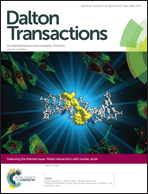Synthesis, cytotoxicity, DNA interaction and cell cycle studies of trans-diiodophosphine Pt(ii) complexes†
Abstract
Platinum complexes, bearing aliphatic amines and phosphine ligands in trans configuration with iodide as leaving groups, are synthesized and characterized. The crystal structure of trans-PtI2(isopropylamine)(PPh3) is reported. The complex bearing isopropylamine is demonstrated to be the best candidate as its cytotoxic activity is comparable to or better than cisplatin. A remarkably higher interaction of the complexes with DNA is reported as compared to the parent chlorido series. Cell cycle studies of the complexes in six human cell lines are performed and also compared with the previous series.

- This article is part of the themed collection: Metal Interactions with Nucleic Acids

 Please wait while we load your content...
Please wait while we load your content...